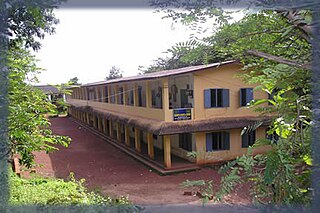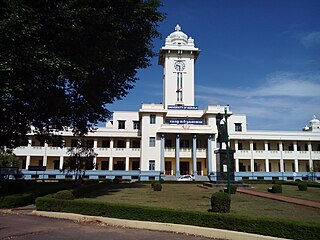The Secondary School Certificate (SSC) or Secondary School Leaving Certificate (SSLC), Matriculation examination, is a public examination in Bangladesh, India, Pakistan and Maldives conducted by educational boards for the successful completion of the secondary education exam in these countries. Students of 10th grade/class ten can appear in these. It is equivalent to the year 10 of the GCSE in England or the first two years of high schools in United States.

Loyola School, Thiruvananthapuram is a private Catholic primary and secondary school located in Sreekariyam, Thiruvananthapuram, in the state of Kerala, India. Founded in 1961, the school has been run by the Jesuits since its establishment.

St. Germain High School is an unaided private institution, established in January 1944. The school began in the former Clergy and Archbishop's House, which had housed St. Joseph's Boys' High School before it moved to its present location in Richmond Town. The school was named after a French priest Rev. Fr. Saint Germain.
Kerala Board of Public Examination is the state level education board of Kerala. It is administered by the Government of Kerala. The board is responsible for conducting various examinations on the basis of a unified law. Its headquarters are located at Pareeksha Bhavan, Poojapura, Thiruvananthapuram.

Christ Nagar Higher Secondary school started in 1976 as a private English Medium School in Trivandrum, India, recognised by the state government of Kerala as a minority educational institution. In 2002, Christ Nagar High School was upgraded to higher secondary level.

John de Britto, SJ, also known as Arul Anandar, was a Portuguese Jesuit missionary and martyr, often called "the Portuguese St Francis Xavier" by Indian Catholics. He is also called the John the Baptist of India.

Railway High School, Palakkad is a high school located in Palakkad city, Kerala, India.This is the only school in the state which is undertaken by Southern Railway.

Government Higher Secondary School Irikkur, Kerala, India, was started in 1957. The school is situated on a mountain about one kilometer away from Irikkur town. The river Irikkur is nearby. The people residing in and around Irikkur are very poor. Mamanam Temple and Nilamuttam Makham are two religious centers near to school.
The Secondary School Leaving Certificate is a certification obtained by a student on successful completion of an examination at the end of study at the secondary schooling level in India. The SSLC is obtained on passing the grade 10 public examination, which is commonly referred to as 'class 10 board examinations' in India. SSLC is a common eligibility examination popular in many states in India, especially Kerala, Karnataka, and Tamil Nadu. The SSLC is also called as Secondary School Certificate (SSC) in Andhra Pradesh, Telangana, Maharashtra and also as High School Certificate (HSC) in Madhya Pradesh and also as Matriculation in many states of India.
In the Indian education system of some Indian states, the pre-university course (PUC) or pre-degree course (PDC) is referred to as intermediate or +2 course, which is a two-year senior secondary education course that succeeds the tenth grade and precedes to the completion of an Senior Secondary Course. The First Year of the PUC is commonly referred to as 1st PUC or Class 11th,, and the Second Year of the PUC as 2nd PUC or Class 12th. A college which offers the PUC is simply known as a 'PU college' or 'Intermediate College' which is also referred to as junior college.
Saint Peter's is a school located in Kadayiruppu, Kolenchery in Kerala State, South India. It caters a co-educational programme from Junior Kindergarten to Grade 12. The school is owned and managed by the Saint Peter's Education Trust, Kadayiruppu, a society within the meaning of the Travancore–Cochin Literary Scientific and Charitable Societies Registration Act 1952.

The importance and antiquity of education in Kerala are underscored by the state's ranking as among the most literate in the country. The educational transformation of Kerala was triggered by the efforts of the Church Mission Society missionaries, who were the pioneers that promoted mass education in Kerala, in the early decades of the 19th century. The local dynastic precursors of modern-day Kerala—primarily the Travancore Royal Family, the Nair Service Society, Sree Narayana Dharma Paripalana Yogam and Muslim Educational Society (MES)—also made significant contribution to the progress on education in Kerala. Local schools were known by the general word kalaris, some of which taught martial arts, but other village schools run by Ezhuthachans were for imparting general education. Christian missionaries and British rule brought the modern school education system to Kerala. Ezhuthu palli was the name used in earlier times. The word was derived from the schools run by the Buddhist monasteries. For centuries villages used to set up an ezhuthupally or ashan pallikoodam with one or two teachers. Students used to go this school from nearby areas and learn languages, literature, mathematics, grammar etc. After completing this students may continue study about specific subjects such as ayurveda, astrology, accounting etc. Censuses during 1800 shows that Travancore, Cochin, Kannur areas have many such schools. Even name list of ashans were used to be published along with the census.
Govt. High School (GHS) is a public school, located in Bangra Manjeshwar, Kasaragod District, Kerala State of India. This high school is affiliated to the Kerala State Education Board. This High School is listed as one of the SSLC examination centres by the Kerala Education Board. This school is one of the very few schools in Kerala that teaches in Kannada Language instead of Malayalam Language.
Sarvodaya Vidyalaya is a school of the Major Archiepiscopal Eparchy of the Syro-Malankara Catholic Church. Situated on the Bethany Hills at Nalanchira, Sarvodaya was founded on 3 January 1973 by Benedict Mar Gregorios, the Metropolitan Archbishop of Trivandrum.
All India Secondary School Examination ( Secondary School Examination)commonly known as Class 10th board exams, is a centralized public examination that students in schools affiliated with the Central Board of Secondary Education, primarily in India but also in other Indian-patterned schools affiliated to the CBSE across the world. taken at the end of class 10. The board conducts the examination during the period of February- March earlier it was taken in March to April every year. In this exam, Mathematics, Science (Physics, Chemistry, Biology) and Social Science (History, Geography, Political Science, Economics) are compulsory with any two languages (official language of medium and foreign/schedule languages). Students can also opt skill subject such as information technology, painting, yoga, music or artificial intelligence. Successful candidates are awarded the Secondary School Completion Certificate, a Statement of Marks, and a Migration Certificate stating that the candidate has completed Secondary Schooling and can pursue higher education. For the academic year 2016–17, the Central Board of Secondary Education has revived the old system of syllabus and marking scheme (complete syllabus for All India Secondary School Examination and marks out of 500 (in COVID time out of 200) India has state exams and central exams.From 2017 to 2018 And later Academic year use old format

Madhya Pradesh Board of Secondary Education is a board of school education in Madhya Pradesh State of India.
The town has a number of secondary, and higher secondary educational institutions, plus a number of Polytechnics, and Engineering Colleges in the vicinity. The Govt. HSS in the town is one of the oldest schools in the entire state. It was established long before in the 1890s. It has churned out a number of proficient people, who have excelled in every field.

St. Albert's HSS is a boys school at Banerji Road in Kochi, India. It was popularly known as St. Albert's High School till 1998, when it was upgraded to a higher secondary school. It is the oldest boys school in Kochi. It has 1800 students and 85 teachers and non teaching staff on a five-acre (2.0 ha) campus.

Mookkannoor Govt. Higher Secondary school is a school situated at Mookkannoor Gram Panchayath, Ernakulam District, Kerala, India. The school is situated in Angamaly assembly constituency. The school was established on 1931. The school is situated near St. Mary's Forane church in Angamaly-Ezattumugham Road.












